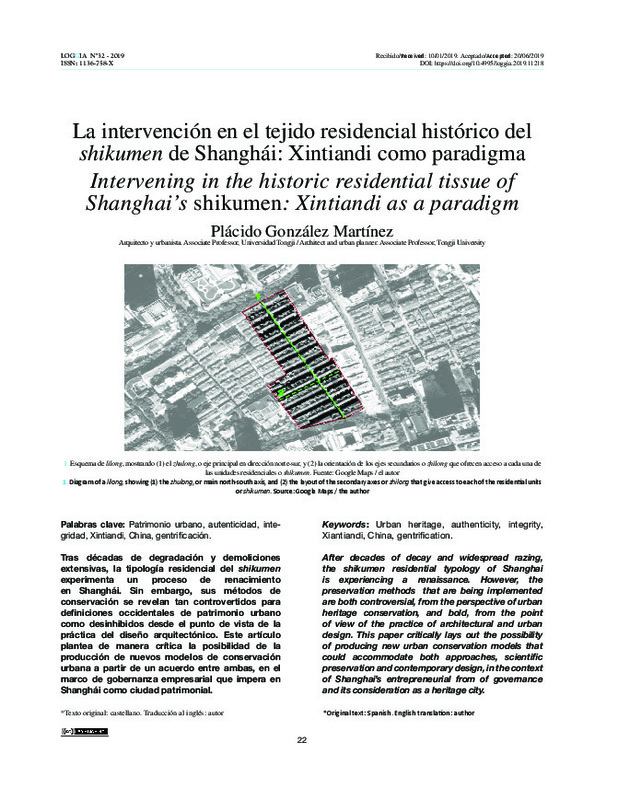Arkaraprasertkul, N. 2010. "Power, politics and the making of Shanghai." Journal of Planning History 9 (4): 232-259. doi:10.1177/1538513210382384.
Chang, Q. (2017). "A Chinese Approach to Urban Heritage Conservation and Inheritance: Focus on the Contemporary Changes of Shanghai's Historic Spaces." Built Heritage 1 (3): 13-33.
Cohen, E., and S. Cohen. 2012. "Authentication: Hot and cool." Annals of Tourism Research 39: 1295-1314. doi:10.1016/j.annals.2012.03.004.
[+]
Arkaraprasertkul, N. 2010. "Power, politics and the making of Shanghai." Journal of Planning History 9 (4): 232-259. doi:10.1177/1538513210382384.
Chang, Q. (2017). "A Chinese Approach to Urban Heritage Conservation and Inheritance: Focus on the Contemporary Changes of Shanghai's Historic Spaces." Built Heritage 1 (3): 13-33.
Cohen, E., and S. Cohen. 2012. "Authentication: Hot and cool." Annals of Tourism Research 39: 1295-1314. doi:10.1016/j.annals.2012.03.004.
Duckett, J. (1996). "The emergence of the entrepreneurial state in contemporary China." The Pacific Review 9 (2): 180-198. doi:10.1080/09512749608719178
Farrer, J. (2010). "'New Shanghailanders' or 'New Shanghainese': Western expatriate's narratives of emplacement in Shanghai." Journal of Ethnic and Migration Studies 36 (8): 1211-1228. doi:10.1080/13691831003687675.
González Martínez, P. (2017). "Urban authenticity at stake: A new framework for its definition from the perspective of heritage at the Shanghai Music Valley." Cities 70: 55-64. doi:10.1016/j.cities.2017.06.017
González Martínez, P. (2018). "From verifiable authenticity to verisimilar interventions: Xintiandi, Fuxing SOHO, and the alternatives to built heritage conservation in Shanghai". International Journal of Heritage Studies. doi: 10.1080/13527258.2018.1557235
Guan, Q., (1996). Lilong housing: a traditional settlement form. Thesis (MArch). McGill University.
He, S. (2007). "State-sponsored gentrification under market transition. The case of Shanghai." Urban Affairs Review 43 (2): 171-198. doi:10.1177/1078087407305175.
He, S. (2009). "New-build gentrification in central Shanghai: Demographic changes and socioeconomic implications." Population, Space and Place 16: 345-361.
He, S., and F. Wu. (2005). "Property-led redevelopment in post-reform China: A case study of Xintiandi redevelopment project in Shanghai." Journal of Urban Affairs27 (1): 1-23. doi:10.1111/j.0735-2166.2005.00222.x.
Hubbert, J. (2017). "Back to the future: The politics of culture at the Shanghai Expo." International Journal of Cultural Studies 20 (1): 48-64. doi:10.1177/1367877915597495.
Jessop, B., and N. L. Sum. (2000). "An entrepreneurial city in action: Hong Kong's emerging strategies in and for (inter)urban competition." Urban Studies 37 (12): 2287-2313. doi:10.1080/00420980020002814.
Liang, S. Y. (2008). "Where the Courtyard Meets the Street: Spatial Culture of the Li Neighborhoods, Shanghai, 1870-1900." Journal of the Society of Architectural Historians 67 (4): 482-503. doi:10.1525/jsah.2008.67.4.482.
Logan, J. R., and H. Molotch. 1987. Urban fortunes: The political economy of place. Berkeley: University of California Press.
Pan, T., and Z. Liu. 2011. "Place Matters." Chinese Sociology & Anthropology 43 (4): 52-73. doi:10.2753/CSA0009-4625430403.
Ren, X. 2014. "The political economy of urban ruins: Redeveloping Shanghai." International Journal of urban and Regional Research 38 (3): 1081-1091. doi:10.1111/ijur.2014.38.issue-3.
Shin, H. B. 2016. "Economic transition and speculative urbanisation in China: Gentrification versus dispossession." Urban Studies 53 (3): 471-489. doi:10.1177/0042098015597111.
UNESCO. 2011. Recommendation on the Historic Urban Landscape. Accessed 08 December 2018 http://whc.unesco.org/en/activities/638
Wang, J. 2009. "Art in capital: Shaping distinctiveness in a culture-led urban regeneration project in Red Town, Shanghai." Cities 26 (6): 318-330. doi:10.1016/j.cities.2009.08.002.
Wang, S. W. H. 2011. "Commercial gentrification and entrepreneurial governance in Shanghai: A case study of Taikang Road Creative Cluster." Urban Policy and Research29 (4): 363-380. doi:10.1080/08111146.2011.598226.
Wong, T. C., and R. Liu. 2016. "Developmental Urbanism, City Image Branding and the "Right to the City" in Transitional China." Urban Policy and Research 35 (2): 210-223. doi:10.1080/08111146.2015.1122587.
Wu, F. 2000. "Place promotion in Shanghai, PRC." Cities (London, England) 17 (5): 349-361. doi:10.1016/S0264-2751(00)00031-7
Zhao, C. 2004. "From 'Shikumen' to New Style: A rereading of 'lilong' housing in modern Shanghai." Journal of Architecture 9 (1): 49-76. doi:10.1080/1360236042000197853
Zheng, S. 2017. "Reflections on architectural heritage conservation in Shanghai." Built Heritage 1 (1): 1-13.
[-]









